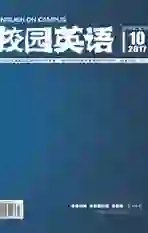Critically assess the use of Contrastive Analysis as an aid to second language teaching
2017-06-02金蕾
金蕾
Contrastive Analysis (CA) has a great impact not only on SLA theory but also on second language classroom teaching. This thesis begins with the analysis of how L2 learning works in CA to further critically evaluate the roles that CA plays in L2 teaching.
There are two theoretical foundations for CA:structuralism and behaviorism. For structuralism, language learning is viewed as the mastery of the units such as phones, phonemes, morphemes, phrases, clauses and sentences and the rules for combining these elements. Likewise, L2 teaching begins at the phonetic level, once this structural level is mastered, then the student advances to the next. However, since the lexicon receives scant attention and the discourse level of language is quite ignored in structuralism, it is impractical for teachers to strictly follow the pyramidally organized sequence.
In accordance with the behavioristic paradigm, L2 learning is also viewed as the process of habit formation. A new habit could be reinforced or impeded by old habit. Transference will take place from L1 to L2.Since the goal of CA is to assist teachers in developing the most effective pedagogical materials, CA recommended that teaching materials be based on a careful examination of both languages.
1. PREDICTION
It would be possible to predict all difficulties in L2 learning based on a careful examination of L1.To teach effectively, a teacher could follow the procedures of description, selection, comparison and prediction. The teacher first describes the formal features of the two languages. Then he chooses a specific area for comparison and finds out similarities and differences of the language in question. This comparison should follow the well-established methodology of structural linguistics. Any target language structure that differs from the learners native language should be given special attention in the preparation of pedagogical materials. Finally, the teacher could make a prediction about where leaners are likely to make errors.
However, CA is criticized on both theoretical and empirical grounds. Theoretical critiques are primarily aimed at the lack of universal grammatical systems, which will allow the teacher to objectively compare languages. Empirical findings contradict the basic assumption of the strong version:Not all the predicted areas of difficulty actually can be observed in the learners performance. The prediction is not 100% accurate. Thus, the role of “Prediction” that CA plays in L2 teaching is not tenable.
2. Diagnosis of Error
The second usage of the CA as an aid to L2 teaching is “Diagnosis of Error”. According to the weak version of CA, the differences between L1 and L2 can be used only to identify some errors that actually arise. In L2 teaching, an important ingredient of the teachers role as monitor and assessor of learners performance is to know why certain errors are committed. Teacher organize feedback to the student and remedial work with diagnostic knowledge. Its necessary for teachers to do CA to see if a particular attested error is explicable in terms of L1 interference for the ultimate purpose of cultivating students ability of self-monitor and avoid these same errors in the future. So it is less “confident” in its power to alleviate problems with L2 teaching.
3. Scales of difficulty
Third application of CA in L2 teaching is “Scales of difficulty”. It is claimed that learning difficulty and difference are directly and proportionally related. The difference between L1 and L2 pose different level of difficulty for L2 learners. Teachers have to pay more attention to the situation where 1) L2 has a rule not matched by L1 or 2) L1 has a rule but L2 has no equivalent than 3) L1 has a rule and L2 an equivalent one. However, it is not always the case. “difference” and “difficulty” are not identical concepts. Difference is linguistic concept in nature, and difficulty is in the psychological domain. Difficulty may be determined by various factors; linguistic difference is one of them. So, it is arbitrary to see these as the same thing in real classroom teaching.
In conclusion, CA is of great use in L2 teaching, especially in terms of prediction, diagnosis of error and scale of difficulty. Nevertheless, the linguistic theory of CA is not flawless and language teaching is a very practical business. we should always take a dialectical attitude towards it.
References:
[1]Carl James,Contrastive Analysis,Qingdao:Qingdao publishing house,2008.
[2]Victoria Fromkin,Robert Rodman,Nina Hyams,An Introduction to Language(Ninth Edition),New York/Artists Rights Society(ARS),New York,NY,U.S.A.2009.
[3]都建穎.第二语言习得理论入门[M].武汉:华中科技大学出版社,2013.
[4]赵扬.第二语言习得[M].北京:外语教学与研究出版社,2015.
